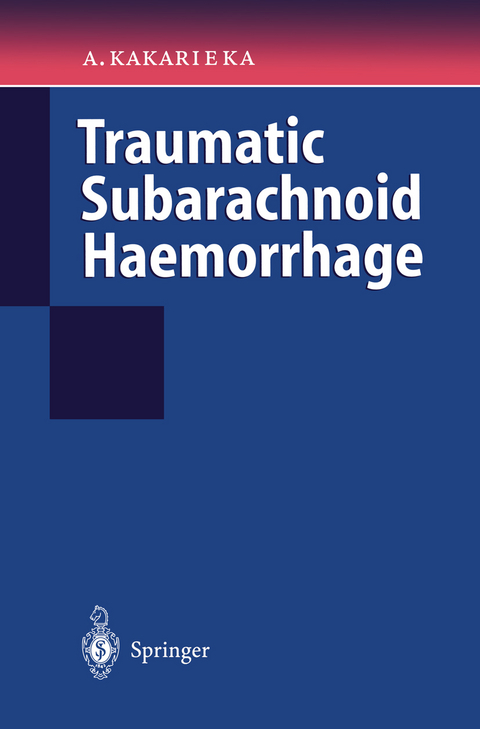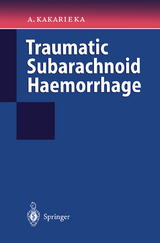Traumatic Subarachnoid Haemorrhage
Springer Berlin (Verlag)
978-3-540-60771-7 (ISBN)
Survey of the Literature.- Pathology.- Incidence.- Relation to Age.- Relation to Alcohol Intoxication.- Prognosis.- Vasospasm and Ischaemic Neurological Deficits After tSAH.- Summary.- Patient Characteristics and Methodology.- Patient Population.- Variables Recorded.- Laboratory Evaluation.- Treatment of Patients.- CT Evaluation.- Criteria for Assessment of Amount of Blood on CT.- Criteria for Classification of the Mechanism of Injury.- Criteria for Defining Severity of Head Injury on Entry to the Trial.- Criteria for Assessment of Outcome.- Biometric Methods.- Summary.- Analysis of CT Findings in tSAH.- Frequency.- Time of CT.- Amount of Blood.- Clearance of tSAH.- Topographic Location of Blood.- Associated CT Findings.- Contusions.- Subdural Haematoma.- Epidural Haematoma.- Intracerebral Haematoma.- Intraventricular Blood.- Signs of Raised ICP on CT.- Hypodensity Compatible with Ischaemia.- Summary.- Demographic and Clinical Aspects of tSAH.- Age.- Sex.- Cause of Injury.- Alcohol Intake Before Injury.- Multiple Injuries.- Interval Between Injury and Admission.- Severity of Head Injury on Entry to the Trial.- Plain Skull X-Rays.- Craniotomy for Removal of Mass Lesions.- Intracranial Pressure Monitoring.- Haemodynamics.- Neurological Status.- Body Temperature.- Mortality.- Summary.- Outcome in tSAH.- Outcome in tSAH.- Amount of Blood and Outcome.- Fisher's Categories and Outcome.- Location of Blood and Outcome.- Associated CT Lesions and Outcome.- Relationship of Various Demographic and Clinical Aspects to Outcome.- Functional Assessment.- Post-traumatic Epilepsy.- Summary.- tSAH as a Prognostic Factor.- Risk of Unfavourable Outcome in tSAH Patients.- Determination of Prognostic Factors.- Summary.- Clinical Laboratory Evaluation in tSAH.- Haematocrit.- Leucocytes.-Platelets.- Serum Aminotransferases.- Serum Lipase.- Serum Amylase.- Summary.- Therapeutic Prospects of tSAH with the Calcium Antagonist Nimodipine.- Pharmacological and Clinical Rational for the Use of the Calcium Antagonist Nimodipine in Head Injury.- The Effect of Nimodipine in the Overall Head-Injury Study Population.- The Effect of Nimodipine on tSAH.- Adverse Events.- Summary.- Confirmation of the Hypothesis: The German tSAH Study.- Patient Population.- Treatment with the Test Drug.- Statistical Analysis.- Demographic Results.- CT Findings.- Transcranial Doppler Blood Flow Velocities.- Blood Pressure and ICP.- Follow-Up Investigation.- Post-traumatic Epilepsy.- Pool Analysis of 460 tSAH Patients.- Summary.- Discussion and Conclusions.- tSAH, a Frequent Finding in Head Injury.- tSAH: CT Aspects.- tSAH: Clinical Aspects.- tSAH and Outcome.- tSAH and Vasospasm.- tSAH and Post-traumatic Epilepsy.- tSAH as a Prognostic Factor.- tSAH and Its Treatment with Nimodipine.- References.
| Erscheint lt. Verlag | 17.9.1996 |
|---|---|
| Zusatzinfo | XII, 109 p. 6 illus. |
| Verlagsort | Berlin |
| Sprache | englisch |
| Maße | 155 x 235 mm |
| Gewicht | 230 g |
| Themenwelt | Medizinische Fachgebiete ► Chirurgie ► Neurochirurgie |
| Medizin / Pharmazie ► Medizinische Fachgebiete ► Neurologie | |
| Medizin / Pharmazie ► Medizinische Fachgebiete ► Notfallmedizin | |
| Schlagworte | Head • Head Injury • Nimodipine • Outcome • subarachnoid haemorrhage • Trauma |
| ISBN-10 | 3-540-60771-4 / 3540607714 |
| ISBN-13 | 978-3-540-60771-7 / 9783540607717 |
| Zustand | Neuware |
| Informationen gemäß Produktsicherheitsverordnung (GPSR) | |
| Haben Sie eine Frage zum Produkt? |
aus dem Bereich





